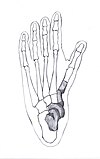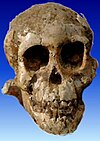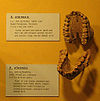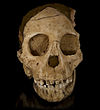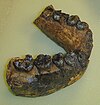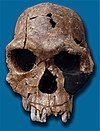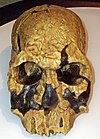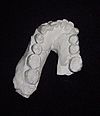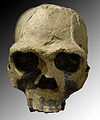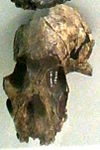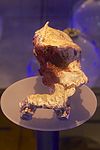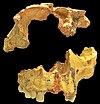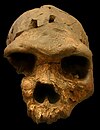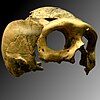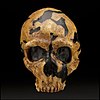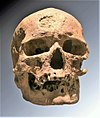List of human evolution fossils: Difference between revisions
MusikAnimal (talk | contribs) m Reverted edits by 209.112.140.132 (talk) (HG) |
Nowimnthing (talk | contribs) →Pliocene: added starter info for LD 350-1 just published yesterday |
||
| Line 188: | Line 188: | ||
| [[Ethiopia]] |
| [[Ethiopia]] |
||
| [[Bill Kimbel]] |
| [[Bill Kimbel]] |
||
| |
|||
|- |
|||
| |
|||
| [[LD 350-1]]<ref>http://www.eurekalert.org/multimedia/pub/87535.php Image at Eurekalert</ref><ref>http://www.eurekalert.org/pub_releases/2015-03/asu-doj022715.php Press Release</ref> |
|||
| 2.75 - 2.8 Ma |
|||
| ''Homo __?'' |
|||
| 2013 |
|||
| [[Ethiopia]] |
|||
| [[Brian A. Villmoare]] |
|||
| |
| |
||
|} |
|} |
||
Revision as of 16:56, 5 March 2015
| Part of a series on |
| Paleontology |
|---|
 |
|
Paleontology Portal Category |
The following tables give a brief overview of several notable hominin fossil finds relating to human evolution beginning with the formation of the Hominini tribe in the late Miocene (roughly 6 million years ago).
As there are thousands of fossils, mostly fragmentary, often consisting of single bones or isolated teeth with complete skulls and skeletons rare,[1] this overview is not complete, but does show some of the most important finds. The fossils are arranged by approximate age as determined by radiometric dating and/or incremental dating and the species name represents current consensus; if there is no clear scientific consensus the other possible classifications are indicated. Deprecated classifications may be found on the fossil's page.
Most of the fossils shown are not considered direct ancestors to Homo sapiens but are closely related to direct ancestors and are therefore important to the study of the lineage.
Late Miocene
7 million - 5.3 million years old
| Name | Age | Species | Year discovered |
Country | Discovered by | Now located at | |
|---|---|---|---|---|---|---|---|

|
TM 266 (Toumai) | 7 Ma[2] | Sahelanthropus tchadensis | 2001 | Chad | Michel Brunet Alain Beauvilain, Fanone Gongdibe, Mahamat Adoum and Ahounta Djimdoumalbaye | |
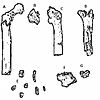
|
BAR 1000'00 | 6 Ma[3] | Orrorin tugenensis | 2000 | Kenya | Martin Pickford, Kiptalam Cheboi, Dominique Gommery, Pierre Mein, Brigitte Senut, |
Pliocene
5.3 million - 2.58 million years old
Pleistocene
Lower Paleolithic: 2.58 million - 300,000
Middle Paleolithic: 300,000 - 50,000 years old
Upper Paleolithic: 50,000 - 10,000 years old
Holocene
Mesolithic / Neolithic: 10,000 - 5000 years old
| Name | Age | Species | Year discovered |
Country | Discovered by | Now located at | |
|---|---|---|---|---|---|---|---|

|
La Brea Woman | ~ 10k | Homo sapiens | 1914 | United States | ||

|
Combe Capelle | 9.6 k[88] | Homo sapiens | 1909 | France | O. Hauser | |
| Cheddar Man | 9k | Homo sapiens | 1903 | UK | |||

|
Kow Swamp 1 | 9k - 13k | Homo sapiens | 1968 | Australia | A.G. Thorne | |
| Afalou 13[citation needed] | 8k - 12k | Homo sapiens | 1920 | Algeria | C. Arambourg | ||
| Wadi Halfa 25[citation needed] | 8k - 12k | Homo sapiens | 1963 | Sudan | G. Armelagos, E. Ewing, D. Greene | ||
| Wadi Kubbaniya[citation needed] | 8k - 20k | Homo sapiens | 1982 | Egypt | Fred Wendorf | ||

|
Minnesota Woman | 7.8 - 8k | Homo sapiens | 1931 | Minnesota, United States | Albert Jenks, via construction crew | |
| Lo 4b[89][90] | 6k - 9k | Homo sapiens | 1965-1975 | H. Robbins B.M. Lynch | |||

|
Tepexpan man | 5k - 11k | Homo sapiens | 1947 | Mexico | H. de Terra | |
| SDM 16704[citation needed] | 4.9k - 11.8 | Homo sapiens | 1929 | United States | M.J. Rogers |
Abbreviations used in fossil catalog name
- AL – Afar Locality, Ethiopia
- ARA-VP – Aramis Vertebrate Paleontology, Ethiopia
- BAR – (Lukeino, Tugen Hills) Baringo District, Kenya
- BOU-VP – Bouri Vertebrate Paleontology, Ethiopia
- D – Dmanisi, Georgia
- ER – East (Lake) Rudolf, Kenya
- KGA – Konso-Gardula, Ethiopia
- KNM – Kenya National Museum
- KP – Kanapoi, Kenya
- LB – Liang Bua, Indonesia
- LH – Laetoli Hominid, Tanzania
- NG – Ngandong, Indonesia
- OH – Olduvai Hominid, Tanzania
- SK – Swartkrans, South Africa
- Sts, Stw – Sterkfontein, South Africa
- TM – Transvaal Museum, South Africa
- TM – Toros-Menalla, Chad
- WT – West (Lake) Turkana, Kenya
See also
- Human evolution
- List of countries and islands by first human settlement
- List of fossil primates
- List of fossil sites
- List of notable fossils
- List of transitional fossils
- Most recent common ancestor
- Paleoanthropology
- Timeline of human evolution
Further reading
- Gibbons, Ann. The First Human: The Race to Discover our Earliest Ancestor. Anchor Books (2007). ISBN 978-1-4000-7696-3
- Hartwig, Walter, ed. (2002. Reprinted 2004). The Primate Fossil Record. Cambridge University Press. ISBN 978-0-521-08141-2Template:Inconsistent citations
{{cite book}}: Check date values in:|year=(help)CS1 maint: postscript (link). - Johanson, Donald & Wong, Kate. Lucy's Legacy: The Quest for Human Origins. Three Rivers Press (2009). ISBN 978-0-307-39640-2
- Jones, Steve; Martin, Robert D.; Pilbeam, David R (Editors). (1994). The Cambridge Encyclopedia of Human evolution. Cambridge University Press. ISBN 978-0-521-46786-5Template:Inconsistent citations
{{cite book}}:|author=has generic name (help)CS1 maint: multiple names: authors list (link) CS1 maint: postscript (link) (Note: this book contains very useful, information dense chapters on primate evolution in general, and human evolution in particular, including fossil history). - Leakey, Richard & Lewin, Roger. Origins Reconsidered: In Search of What Makes us Human. Little, Brown and Company (1992). ISBN 0-316-90298-5
- Lewin, Roger. Bones of Contention: Controversies in the Search for Human Origins. Penguin Books (1987). ISBN 0-14-022638-9
- Morwood, Mike & van Oosterzee, Penny. A New Human: The Startling Discovery and Strange Story of the 'Hobbits' of Flores, Indonesia. Smithsonian Books (2007). ISBN 978-0-06-089908-0
- Oppenheimer, Stephen. Out of Eden: The Peopling of the World. Constable (2003). ISBN 1-84119-697-5
- Roberts, Alice. The Incredible Human Journey: The Story of how we Colonised the Planet. Bloomsbury (2009). ISBN 978-0-7475-9839-8
- Shreeve, James. The Neanderthal Enigma: Solving the Mystery of Modern Human Origins. Viking (1996). ISBN 0-670-86638-5
- Stringer, Chris. The Origin of Our Species. Allen Lane (2011). ISBN 978-1-84614-140-9
- Stringer, Chris & Andrews, Peter. The Complete World of Human Evolution. Thames & Hudson (2005). ISBN 0-500-05132-1
- Stringer, Chris & McKie, Robin. African Exodus: The Origins of Modern Humanity. Jonathan Cape (1996). ISBN 0-224-03771-4
- van Oosterzee, Penny. The Story of Peking Man. Allen & Unwin (1999). ISBN 1-86508-632-0
- Walker, Allan & Shipman, Pat. The Wisdom of the Bones: In Search of Human Origins. Weidenfeld and Nicholson (1996). ISBN 0-297-81670-5
- Wade, Nicholas. Before the Dawn: Recovering the Lost History of our Ancestors. Penguin Press (2006). ISBN 978-0-7156-3658-9
- Weiss, M.L., & Mann, A.E. (1985). "'Human Biology and Behaviour: An anthropological perspective" (4th ed.). Boston: Little Brown. ISBN 978-0-673-39013-4Template:Inconsistent citations
{{cite journal}}: Cite journal requires|journal=(help)CS1 maint: multiple names: authors list (link) CS1 maint: postscript (link) (Note: this book contains very accessible descriptions of human and non-human primates, their evolution, and fossil history). - Template:Cite isbn
References
- ^ "Prominent Hominid Fossils". Retrieved 2006-08-31.
- ^ "Fossil Hominids: Toumai". Talkorigins.org. 2002-07-31. Retrieved 2012-10-15.
- ^ "Bar 10200'". Smithsonian National Museum of Natural History. Retrieved 2012-07-27.
- ^ Amos, Jonathan (2009-10-01). "Fossil finds extend human story". BBC News.
- ^ I. A. N., McDougall; Craig, Feibel (1999). "Numerical age control for the Miocene-Pliocene succession at Lothagam, a hominoid-bearing sequence in the northern Kenya Rift". Journal of the Geological Society. 156: 731–745. doi:10.1144/gsjgs.156.4.0731.
- ^ a b c Hill, Andrew; Ward, Steven (1988). "Origin of the Hominidae: the record of African large hominoid evolution between 14 My and 4 My". Yearbook of Physical Anthropology. 31 (59): 49–83. doi:10.1002/ajpa.1330310505.
- ^ Patterson B, Behrensmeyer AK, Sill WD (June 1970). "Geology and fauna of a new Pliocene locality in north-western Kenya". Nature. 226 (5249): 918–21. doi:10.1038/226918a0. PMID 16057594.
{{cite journal}}: CS1 maint: multiple names: authors list (link) - ^ lothagam mandible fragment
- ^ Ward, Steven; Hill, Andrew. "Pliocene hominid partial mandible from Tabarin, Baringo, Kenya". American Journal of Physical Anthropology. 72 (1): 21–37. doi:10.1002/ajpa.1330720104.
- ^ Heslip, Steven (2001). "Australopithecus anamensis". Archived from the original on June 8, 2011.[self-published source?]
- ^ "Oldupai". Ntz.info. Retrieved 2012-10-15.
- ^ KNM-WT 40000
- ^ Smithsonian
- ^ http://www.modernhumanorigins.net/al444-2.html Image at Modern Human Origins
- ^ http://www.eurekalert.org/multimedia/pub/87535.php Image at Eurekalert
- ^ http://www.eurekalert.org/pub_releases/2015-03/asu-doj022715.php Press Release
- ^ http://travelmag.co.uk/?p=1254
- ^ http://www.modernhumanorigins.net/sts14.html Image at Modern Human Origins
- ^ http://humanorigins.si.edu/evidence/human-fossils/fossils/sts-71 Image at Smithsonian
- ^ http://www.modernhumanorigins.net/sts52.html Image at Modern Human Origins
- ^ Department of Anthropology: The University of Texas at Austin. "Paranthropus robustus: TM 1517". Retrieved 2014-06-09.
- ^ http://www.scientificamerican.com/article.cfm?id=south-african-hominin-fossil MH1 image at Scientific American
- ^ Juliet King (June 4, 2010). "Australopithecus sediba fossil named by 17-year-old Johannesburg student". Origins Centre. Retrieved 2011-07-09.
- ^ Jonathan, Amos (2011-09-08). "African fossils put new spin on human origins story". http://www.sciencemag.org/site/extra/sediba/index.xhtml. BBC News. Retrieved 9 September 2011.
{{cite news}}: External link in|work= - ^ Mai, L.L., Owl, M.Y., & Kersting, M.P. (2005), p.286
- ^ http://humanorigins.si.edu/evidence/3d-collection/oh-24 Image at Smithsonian
- ^ http://www.modernhumanorigins.net/oh8.html OH 8 image of foot at Modern Human Origins
- ^ a b c Leakey MG, Spoor F, Dean MC; et al. (August 2012). "New fossils from Koobi Fora in northern Kenya confirm taxonomic diversity in early Homo". Nature. 488 (7410): 201–4. doi:10.1038/nature11322. PMID 22874966.
{{cite journal}}: Explicit use of et al. in:|author=(help)CS1 maint: multiple names: authors list (link)F - ^ "Homo ergaster". Australian Museum. Retrieved July 7, 2014.
- ^ Inverted strata
- ^ Donald C. Johanson, Blake Edgar (1996). From Lucy to Language. New York, NY: Simon & Schuster. p. 158.
- ^ http://humanorigins.si.edu/evidence/3d-collection/knm-er-23000 Image at Smithsonian
- ^ http://www.modernhumanorigins.net/stw53.html STW 53 image at Modern Human Origins
- ^ http://www.modernhumanorigins.net/sk847.html SK 847 image at Modern Human Origins
- ^ http://www.modernhumanorigins.net/dnh7.html DNH 7 image at Modern Human Origins
- ^ http://humanorigins.si.edu/evidence/human-fossils/fossils/sk-46 Image at Smithsonian
- ^ http://www.modernhumanorigins.net/oh9.html Chellean OH 9 Image at Modern Human Origins
- ^ Michael Hopkin (March 26, 2008). "Fossil find is oldest European yet". Nature News. doi:10.1038/news.2008.691.
- ^ http://www.sciencedirect.com/science/article/pii/S0012821X13007462]
- ^ http://onlinelibrary.wiley.com/doi/10.1002/ajpa.20739/pdf]
- ^ http://humanorigins.si.edu/evidence/human-fossils/fossils/trinil-2 Image at Smithsonian
- ^ http://www.modernhumanorigins.net/sangiran17.html Sangiran 17 image at Modern Human Origins
- ^ http://archive.archaeology.org/9809/newsbriefs/eritrea.html
- ^ http://www.modernhumanorigins.net/bodo.html Bodo image at Modern Human Origins
- ^ https://www.msu.edu/~heslipst/contents/ANP440/images/Saldanha.JPG Saldanha man[dead link][self-published source?]
- ^ http://www.modernhumanorigins.net/pa830.html Hexian PA830 image at Modern Human Origins
- ^ Peter Brown. "Hexian". Peter Brown's Australian & Asian Palaeoanthropology. Retrieved 2014-05-18.
- ^ http://humanorigins.si.edu/evidence/3d-collection/ndutu Image at Smithsonian
- ^ http://humanorigins.si.edu/evidence/3d-collection/petralona-1 Smithsonian's Human Origins Program
- ^ http://www.modernhumanorigins.net/dali.html Dali image at Modern Human Origins
- ^ P. Brown Dali archaic Homo Sapiens[dead link][self-published source?] University of New England, Australia
- ^ http://www.modernhumanorigins.net/omo1.html Omo 1 Image at Modern Human Origins
- ^ http://www.modernhumanorigins.net/omo2.html Omo II Image at Modern Human Origins
- ^ http://www.abc.net.au/science/news/stories/s877478.htm Herto skull images at ABC Science
- ^ http://www.eva.mpg.de/evolution/files/irhoud.htm Jebel Irhoud 1 skull image at Max Planck Institute
- ^ Smith TM, Tafforeau P, Reid DJ; et al. (April 2007). "Earliest evidence of modern human life history in North African early Homo sapiens". Proceedings of the National Academy of Sciences of the United States of America. 104 (15): 6128–33. doi:10.1073/pnas.0700747104. PMC 1828706. PMID 17372199.
{{cite journal}}: Explicit use of et al. in:|author=(help); Unknown parameter|laydate=ignored (help); Unknown parameter|laysource=ignored (help); Unknown parameter|laysummary=ignored (help)CS1 maint: multiple names: authors list (link) - ^ http://www.modernhumanorigins.net/tabun1.html Tabun 1 Image at Modern Human Origins
- ^ "Saccopastore 1". Smithsonian: National Museum of Natural History. Retrieved 2015-02-15.
- ^ http://www.modernhumanorigins.net/krapinac.html Krapina C Images at Modern Human Origins
- ^ a b c d e f g h i j Smith TM, Tafforeau P, Reid DJ; et al. (December 2010). "Dental evidence for ontogenetic differences between modern humans and Neanderthals". Proceedings of the National Academy of Sciences of the United States of America. 107 (49): 20923–8. doi:10.1073/pnas.1010906107. PMC 3000267. PMID 21078988.
{{cite journal}}: Explicit use of et al. in:|author=(help)CS1 maint: multiple names: authors list (link) - ^ http://www.modernhumanorigins.net/qafzeh6.html Qafzeh VI images at Modern Human Origins
- ^ Qafzeh IX
- ^ http://www.modernhumanorigins.net/qafzeh6.html Qafzeh VI Image at Modern Human Origins
- ^ http://www.modernhumanorigins.net/klasies.html Klasies Images at Modern Human Origins
- ^ Norton, Christopher J.; Braun, David R. Asian paleanthropology: From Africa to China and beyond. New York, NY: Springer. p. 107. doi:10.1007/978-90-481-9094-2. ISBN 978-90-481-9093-5.
- ^ "What does it mean to be human?". Smithsonian National Museum of Natural History. Retrieved July 27, 2012.
- ^ http://www.modernhumanorigins.net/amud7.html Amud 7 Image at Modern Human Origins
- ^ http://www.modernhumanorigins.net/amud1.html Amud 1 Image at Modern Human Origins
- ^ "Human evolution: interpreting evidence". Museum of Science, Boston, US. Retrieved July 27, 2012.
- ^ http://www.modernhumanorigins.net/circeo.html Mount Circeo 1 Image at Modern Human Origins
- ^ http://www.modernhumanorigins.net/neanderthal1.html Neanderthal 1 images at Modern Human Origins
- ^ http://news.softpedia.com/newsImage/Experts-Recreate-the-Face-of-the-First-European-2.jpg/ Images of Peştera cu Oase[self-published source?]
- ^ Timeline at Bone & Stone
- ^ http://www.modernhumanorigins.net/predmosti3.html Predmosti 3 images at Modern Human Origins
- ^ a b Schulting RJ, Trinkaus E, Higham T, Hedges R, Richards M, Cardy B (May 2005). "A Mid-Upper Palaeolithic human humerus from Eel Point, South Wales, UK". Journal of Human Evolution. 48 (5): 493–505. doi:10.1016/j.jhevol.2005.02.001. PMID 15857652.
{{cite journal}}: CS1 maint: multiple names: authors list (link) - ^ http://www.modernhumanorigins.net/minatogawa1.html Minatogawa 1 images at Modern Human
- ^ Template:Cita magazine
- ^ "Lake Tandou Skull". Australia: The Land Where Time Began. Retrieved 2014-05-19.
- ^ Stringer, C. B. (1985). "The hominid remains from Gough's Cave" (PDF). Proceedings of the University of Bristol Spelaeological Society. 17 (2): 145–52.
- ^ McKie, Robin (June 20, 2010). "Bones from a Cheddar Gorge cave show that cannibalism helped Britain's earliest settlers survive the ice age". The Observer. Guardian. Retrieved 2012-10-15.
- ^ "Mystery of a West African skull from 13,000 years ago". Natural History Museum, London, UK. Retrieved July 27, 2012.
- ^ Johnson, John. "Arlington Man". National Park Service. Retrieved December 25, 2014.
- ^ Leroy-Gourhan, Michel Brézillon ; preface by André (1969). Dictionnaire de la préhistoire (Ed. rev. & corr. ed.). Paris: Larousse. ISBN 2-03-075437-4.
{{cite book}}: CS1 maint: multiple names: authors list (link) - ^ C. Smith (1999). "Who Was First? Untangling America's Prehistoric Roots". Discovery Communications Inc. Retrieved July 2, 2014.
- ^ Bird, Junius B. (1988). "Four views of skull from skeleton 99.1/779". In Hyslop, John (ed.). Travels and Archaeology in South Chile. University of Iowa Press. p. 214. ISBN 978-1-58729-014-5.
{{cite book}}: External link in|chapterurl=|chapterurl=ignored (|chapter-url=suggested) (help) - ^ Travels and Archeology in South Chile. Cornell University, New York, U.S. Retrieved August 21, 2013.
- ^ Storm, Paul; Nelson, Andrew (1992). "The many faces of Wadjak man". Archaeology Oceania. 27 (1): 37–46. JSTOR 40386932.
- ^ Seidler, Christoph (9 February 2011). "Forscher entzaubern Steinzeitmann". Der Spiegel (in German). Retrieved 2012-04-19.
- ^ Powell, Joseph F. (2005). The First Americans: Race, Evolution and the Origin of Native Americans (Google Books). Cambridge University Press. pp. 169–170. ISBN 9780521530354. Retrieved 2015-01-25.
- ^ Angel, J.L.; Phenice, T.W.; Robbins, L.H.; Lynch, B.M. (1980). Late stone age fishermen of Lothegam, Kenya. National Anthropological Archives, Sithsonian Institution, Part 3.
Bibliography
- Tattersall, Ian, Schwartz, Jeffery (2000). Extinct Humans. Westview Press, Boulder CO. ISBN 978-0-8133-3482-0.
{{cite book}}: CS1 maint: multiple names: authors list (link) - Larsen, Clark Spencer, Matter, Robert M, Gebo, Daniel L (1991). Human Origins: the fossil record. Waveland Press, Prospect Heights, IL. ISBN 978-0-88133-575-0.
{{cite book}}: CS1 maint: multiple names: authors list (link) - "Smithsonian Human Origins Program". Retrieved 2006-08-29.
- "Prominent Hominid Fossils". Retrieved 2006-08-31.
- Grine, F.E.; Jungers, W.L.; Schultz, J. (1996). "Phenetic Affinities Among Early Homo Crania from East and South Africa". Journal of Human Evolution. 30 (3): 189–225. doi:10.1006/jhev.1996.0019.






